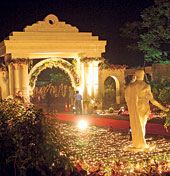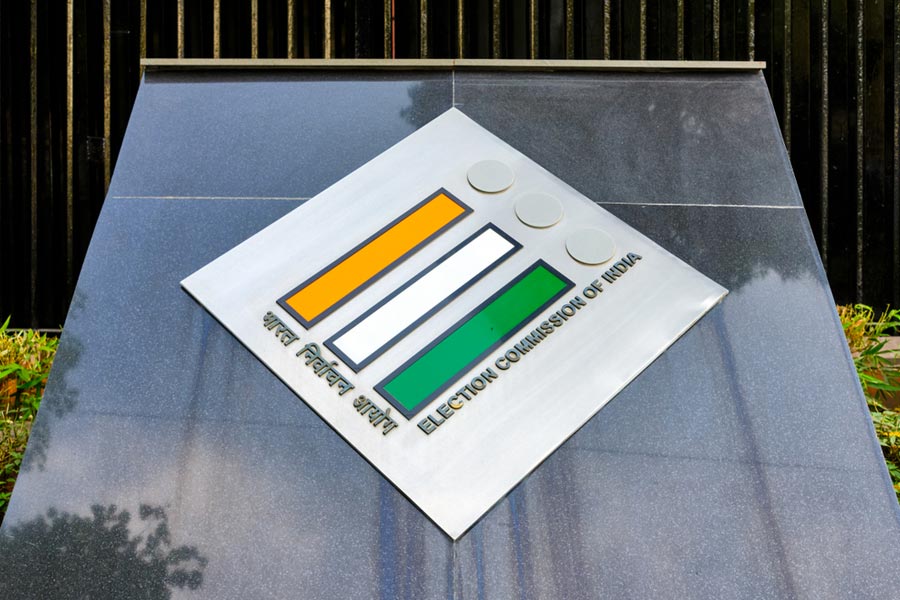 |
| Roman and Rajasthani are two popular themes for Bengali weddings |
Once the uppity Mr Sen from Salt Lake had sneered —“chhi” — at Shah Rukh Khan jiving on the lawns of Victoria Memorial for L.N. Mittal’s son’s wedding. A few years later, he is poring over the mehndi budget of his daughter’s wedding. Mehndi will be followed by the sangeet ceremony, with DJs as emcees.
Bengalis are wedding but Bengali weddings are no more. They lost their pure Bangali status about two decades ago with the advent of chilli fish on the menu card. But over the last five years, macaroni salad, vegetable au gratin and Thai-style chicken are not the only things to change the Bengali wedding. At times now, it is pure Bollywood. And wedding cakes.
Pre-marital jazz
It starts at the very beginning, with mehndi and sangeet. Mehndi and sangeet? Yes, the heady stuff that happened between Madhuri Dixit and Salman Khan in Hum Aapke Hai Kaun, involving backless cholis, men aiming at backless cholis and wondrous hip spins, is happening in Bengali homes. Or at expensive rented addresses. The Bengali wedding, formerly a “boring” three-day (more like two-day really) affair, is now a sizzling seven-day carnival, with naacha, gaana, khaana and peena. Cheers.
This February the Chakrabortys of Ballygunge hosted a sangeet based on the reality dance show Nach Baliye, with couples in the family taking turns to dance to Hindi chartbusters. To throw in more masala, the bride’s cousins posed as “Munnabhai and Circuit (in dhoti-kurta) in Calcutta”.
 |
 |
 |
| Before and after: (From top) Uttam Kumar and Suchitra Sen in Indrani and Koel Mullick and Jisshu Sengupta in Bor Ashbe Ekhuni |
At times, mehndi and sangeet are concessions to the presence of “non-Bengali” members in the family and friends. The new Bong speaks many languages. In fact, she may not know Bengali bhalo kore.
Priya Roy, a 28-year-old media professional, had a two-day pre-wedding bash. “Many of my cousins have married non-Bongs. My cousins put up a dance act and eventually my mom, aunts and I joined in. The next day we had our registration, followed by a cocktail party. My in-laws and elders were quite sporting about the alcohol and everyone danced,” smiles Priya.
Choreographers are in great demand. They see the families through 15 days of easy step rehearsals to Where’s the party tonight or Nimbuda nimbuda and the ready script of a skit that is performed with the songs before the final act.
It’s a sign of the times. Or is it contemporary Bengali trying to be Indian, as in Bollywood Indian, or even global, with the wedding cake, perhaps also mediated by Bollywood? Or is it just get what money can buy?
“Wedding malls and wedding fairs have made marriages a very big consumer event. At one level it’s consumerism and at another it’s a certain desire for glamour,” says Tapati Guhathakurta, a historian at the Centre for Studies in Social Sciences.
The desire often liberates the marriage from family residences, staid “marriage houses” and community halls into five-star properties and open spaces, to allow late-night partying and custom-made décor. If mehndi and sangeet are in, so are “bachelor” or “bachelorette” parties — at Shisha, Venom, Dublin or some “exclusive venue” replete with fire-eaters and juggler-bartenders.
One agent of change is the non-resident Bong. They live abroad and come back home for a big, fun marriage, but with the dhakka-par dhuti that makes you feel sooo Bengali.
“It’s been three or four years that the trend has set in. NRBs want a good mix of entertainment and we were quite surprised when Bengali families started calling us to play at their weddings,” says DJ Harish of Dublin, who spins the console at eight to 10 sangeets or bachelor and cocktail parties for Bengali weddings every season.
A new DJ may charge about Rs 5,000, a pro much more. DJ Harish charges Rs 20,000 per show while DJ Vicky starts at Rs 40,000 and can go up to a lakh.
Devleena Chakraverty’s husband played DJ at their pre-wedding cocktail party on the roof of his friend’s apartment building. Fashion designer Suchismita Dasgupta had the rock band Span playing at hers. Model Sanjukta Das planned her boyfriend’s (now husband’s) bachelor party only to be left out. “They wanted to make a boys’ night out of it,” she says.
Many feel the new spending power is to be blamed. “The Bengali marriage rules have been compromised in many ways to accommodate something modern or post-modern,” says sociologist Prashanta Roy.
“But what is happening now is basically a syndrome among the moneyed class with a surplus to spend and a mindset to do something that many wouldn’t, even if it appears ridiculous or senseless.”
The new frills may not be the preserve of the rich alone. Recently in a middle-class Salt Lake housing estate, all the ladies, young and old, of an apartment came together, holding hands, dancing in a circle while singing Bengali songs, to greet a bride.
“The change is not just among the elite but spills over to the common man,” says Guhathakurta.
Old habits
Are Bengali rituals also dying? No. The point is to have as many ceremonies as possible. So ashirbaad (blessings from future in-laws), odhibaas (gift ceremony) and dodhimangal (curd-rice at dawn, to be followed by fasting) are still there, but new and improved. As in television serials or Sanjay Leela Bhansali’s Devdas, Bengali tradition is being reinvented – sometimes multiplied. “Sabeki” is ok, but retro is chic only when it rocks.
The ashirbaad in its new avatar is the “ring ceremony”. Deepanjana Majumdar, 24, who married Anirban in June, celebrated her engagement with family at ITC Sonar. She had her aiburo-bhaat (single woman’s send-off meal) on two occasions: once thrown for her by her elder sister, which was followed by a “bachelorette” party, and the second by her mom the day before the wedding.
Things are very mixed up. For the Rudras of Salt Lake, the wedding rituals were organised in the afternoon with amber lights, shola decoration and the pundit reading out mantras in English, Bengali and Hindi on a mike while the guests were handed booklets with the mantras.
“Once the rituals were over, we transformed the entire place into a dance floor, with a wedding cake and a red carpet for the couple to walk down and exchange wedding vows,” says Vinod Bhandari of Wedding Xtraordinaire.
Wedding cakes are quite a rage. “I had a three-tier chocolate wedding cake with strawberry icing. We cut it right after our registration. I grew up in a Christian state and always fancied the wedding cake so my mum arranged it specially for me,” beams Priya.
One of Deepanjana’s aiburobhaats was followed by a sangeet that was attended by the men of the family as well. There was a lot of “dancing, drinking and chatting”. So much so that no one managed to wake up for her dodhimongol.
Do as the Romans do
Add to the potpourri designer trousseaus, flower-laden palanquins and bespoke cards. A Honda City or a Mitsubishi Lancer is acceptable but some prefer a palki or a horse. A short-dark Bangali bor on a white horse? Hope they leave the sword out.
“For a Bengali wedding, we had the groom arriving on a bullock cart (we love that one) dressed in a white dhoti. In another, the bride arrived in an open palki and left in a covered doli,” says Bhandari.
As in the pujas, there are themes for weddings. Eventure Events organised the wedding for the Chakrabortys, on a “Thai theme”. “We set up Thai figures and pillars in red and gold on a bamboo structure decked with white, yellow and red orchid. The waiters sported traditional Thai clothes and we flew down a Thai lady who sat and played a string instrument,” says Geetish Agarwal of Eventure Events.
“Roman” — after all, there isn’t much difference between a toga and a dhoti — and “Rajasthani” are other popular themes. So is “traditional Bengali”, with jhinchak, razzle-dazzle.
Why does a Bengali have to recreate a “Bengali theme”? What is to happen to the Bengali?
Here’s what is happening to the Bengali man. “Bengali men are opting for sherwanis, bandhgalas, achkans and angrakhas, which are more national and go with the mood of different days of an extended wedding affair,” says fashion designer Sharbari Dutta.
There you have it — Bollywood.
“Girls are opting for a contemporary pan-Indian look with minimal make-up in warm tones of rust, pink, maroon or orange,” says make-up pro Aniruddha Chakladar.
Translated, “pan-India” means Bollywood.
Some are disturbed. Priya Ray Chaudhuri, 23, who has just finished her post-graduate studies in psychology, is outraged. “Why are we copying other cultures when they aren’t copying us? Why Manish Malhotra? Why not Adi Dhakeshwari Bastralaya? If it worked for your mum, why can’t it work for you?”
It may work for you, Priya, but it doesn’t for every second Bengali household that is grooming its child to win a Hindi music talent show.
Bollywood is the gold standard.
“The concept of fun has changed because people are keen on readymade fun supplied by the market and not self-made fun,” says poet and writer Nabarun Bhattacharya.
The Bengali may be stuck at Singur but has come a long way with the sindur.
Marriage package
 |
![]() Sangeet, mehndi: Rs 30,000-Rs 2,00,000
Sangeet, mehndi: Rs 30,000-Rs 2,00,000
![]() Bachelor/ Bachelorette party: Rs 500-Rs 1,100 per person in a nightclub
Bachelor/ Bachelorette party: Rs 500-Rs 1,100 per person in a nightclub
![]() Cocktail party: At least Rs 1 lakh. The amount can double depending on the DJ, location and the lights
Cocktail party: At least Rs 1 lakh. The amount can double depending on the DJ, location and the lights










